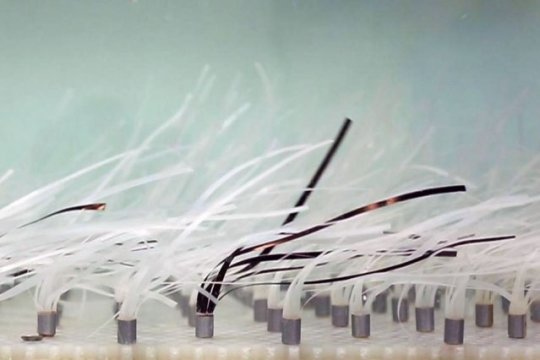[ad_1]
Most people’s experience with seagrass, if any, amounts to little more than a tickle on their ankles while wading in shallow coastal waters. But it turns out these ubiquitous plants, varieties of which exist around the world, could play a key role in protecting vulnerable shores as they face onslaughts from rising sea levels.
New research for the first time quantifies, through experiments and mathematical modelling, just how large and how dense a continuous meadow of seagrass must be to provide adequate damping of waves in a given geographic, climatic, and oceanographic setting.
In a pair of papers appearing in the May issues of two research journals, Coastal Engineering and the Journal of Fluids and Structures, MIT professor of civil and environmental engineering Heidi Nepf and doctoral student Jiarui Lei describe their findings and the significant environmental benefits seagrass offers. These include not only preventing beach erosion and protecting seawalls and other structures, but also improving water quality and sequestering carbon to help limit future climate change.
Those services, coupled with better-known services such as providing habitat for fish and food for other marine creatures, mean that submerged aquatic vegetation including seagrass provides an overall value of more than $4 trillion globally every year, as earlier studies have shown. Yet today, some important seagrass areas such as the Chesapeake Bay are down to about half of their historic seagrass coverage (having rebounded from a low of just 2 percent), thus limiting the availability of these valuable services.
Nepf and Lei recreated artificial versions of seagrass, assembled from materials of different stiffness to reproduce the long, flexible blades and much stiffer bases that are typical of seagrass plants such as Zostera marina, also known as common eelgrass. They set up a meadow-like collection of these artificial plants in a 79-foot-long (24-meter) wave tank in MIT’s Parsons Laboratory, which can mimic conditions of natural waves and currents. They subjected the meadow to a variety of conditions, including still water, strong currents, and wave-like sloshing back and forth. Their results validated predictions made earlier using a computerized model of individual plants.
The researchers used the physical and numerical models to analyze how the seagrass and waves interact under a variety of conditions of plant density, blade lengths, and water motions. The study describes how the motion of the plants changes with blade stiffness, wave period, and wave amplitude, providing a more precise prediction of wave damping over seagrass meadows. While other research has modeled some of these conditions, the new work more faithfully reproduces real-world conditions and provides a more realistic platform for testing ideas about seagrass restoration or ways of optimizing the beneficial effects of such submerged meadows, they say.
To test the validity of the model, the team then did a comparison of the predicted effects of seagrass on waves, looking at one specific seagrass meadow off the shore of the Spanish island of Mallorca, in the Mediterranean Sea, which is known to attenuate the force of incoming waves by a factor of about 50 percent on average. Using measurements of meadow morphology and wave velocities collected in a previous study led by Professor Eduardo Infantes, currently of Gothenburg University, Lei was able to confirm the predictions made by the model, which analyzed the way the tips of the grass blades and particles suspended in the water both tend to follow circular paths as waves go by, forming circles of motion known as orbitals.
The observations there matched the predictions very well, Lei says, showing the way wave strength and seagrass motion varied with distance from the edge of the meadow to its interior agreed with the model. So, “with this model the engineers and practitioners can assess different scenarios for seagrass restoration projects, which is a big deal right now,” he says That could make a significant difference, he says, because now some restoration projects are considered too expensive to undertake, whereas a better analysis could show that a smaller area, less expensive to restore, might be capable of providing the desired level of protection. In other areas, the analysis might show that a project is not worth doing at all, because the characteristics of the local waves or currents would limit the grasses’ effectiveness.
The particular seagrass meadow in Mallorca that they studied is known to be very dense and uniform, so one future project is to extend the comparison to other seagrass areas, including those that are patchier or less thickly vegetated, Nepf says, to demonstrate that the model can indeed be useful under a variety of conditions.
By attenuating the waves and thus providing protection against erosion, the seagrass can trap fine sediment on the seabed. This can significantly reduce or prevent runaway growth of algae fed by the nutrients associated with the fine sediment, which in turn causes a depletion of oxygen that can kill off much of the marine life, a process called eutrophication.
Seagrass also has significant potential for sequestering carbon, both through its own biomass and by filtering out fine organic material from the surrounding water, according to Nepf, and this is a focus of her and Lei’s ongoing research. An acre of seagrass can store about three times as much carbon as an acre of rainforest, and Lei says preliminary calculations suggest that globally, seagrass meadows are responsible for more than 10 percent of carbon buried in the ocean, even though they occupy just 0.2 percent of the area.
The work was funded by the U.S. National Science Foundation.
[ad_2]















